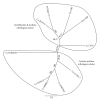Sulfurous gases as biological messengers and toxins: comparative genetics of their metabolism in model organisms
- PMID: 22131987
- PMCID: PMC3216388
- DOI: 10.1155/2011/394970
Sulfurous gases as biological messengers and toxins: comparative genetics of their metabolism in model organisms
Abstract
Gasotransmitters are biologically produced gaseous signalling molecules. As gases with potent biological activities, they are toxic as air pollutants, and the sulfurous compounds are used as fumigants. Most investigations focus on medical aspects of gasotransmitter biology rather than toxicity toward invertebrate pests of agriculture. In fact, the pathways for the metabolism of sulfur containing gases in lower organisms have not yet been described. To address this deficit, we use protein sequences from Homo sapiens to query Genbank for homologous proteins in Caenorhabditis elegans, Drosophila melanogaster, and Saccharomyces cerevisiae. In C. elegans, we find genes for all mammalian pathways for synthesis and catabolism of the three sulfur containing gasotransmitters, H(2)S, SO(2) and COS. The genes for H(2)S synthesis have actually increased in number in C. elegans. Interestingly, D. melanogaster and Arthropoda in general, lack a gene for 3-mercaptopyruvate sulfurtransferase, an enzym for H(2)S synthesis under reducing conditions.
Figures





Similar articles
-
The Redox System in C. elegans, a Phylogenetic Approach.J Toxicol. 2012;2012:546915. doi: 10.1155/2012/546915. Epub 2012 Jul 31. J Toxicol. 2012. PMID: 22899914 Free PMC article.
-
Cadherin superfamily proteins in Caenorhabditis elegans and Drosophila melanogaster.J Mol Biol. 2001 Feb 2;305(5):1011-24. doi: 10.1006/jmbi.2000.4361. J Mol Biol. 2001. PMID: 11162110
-
Codon usage by transposable elements and their host genes in five species.J Mol Evol. 2002 May;54(5):625-37. doi: 10.1007/s00239-001-0059-0. J Mol Evol. 2002. PMID: 11965435
-
Interaction among Hydrogen Sulfide and Other Gasotransmitters in Mammalian Physiology and Pathophysiology.Adv Exp Med Biol. 2021;1315:205-236. doi: 10.1007/978-981-16-0991-6_9. Adv Exp Med Biol. 2021. PMID: 34302694 Review.
-
Biological consilience of hydrogen sulfide and nitric oxide in plants: Gases of primordial earth linking plant, microbial and animal physiologies.Nitric Oxide. 2016 May 1;55-56:91-100. doi: 10.1016/j.niox.2016.04.002. Epub 2016 Apr 13. Nitric Oxide. 2016. PMID: 27083071 Review.
Cited by
-
An HBT-Based Near-Infrared Fluorescent Probe for Colorimetric and Ratiometric Detection of Bisulfite and its Application in Living Cells.J Fluoresc. 2017 Jul;27(4):1405-1411. doi: 10.1007/s10895-017-2077-3. Epub 2017 Apr 9. J Fluoresc. 2017. PMID: 28391542
-
Hydrogen sulfide is an endogenous regulator of aging in Caenorhabditis elegans.Antioxid Redox Signal. 2014 Jun 1;20(16):2621-30. doi: 10.1089/ars.2013.5448. Epub 2013 Nov 21. Antioxid Redox Signal. 2014. PMID: 24093496 Free PMC article.
-
Novel biosynthetic pathway for sulfur amino acids in Cryptococcus neoformans.Curr Genet. 2018 Jun;64(3):681-696. doi: 10.1007/s00294-017-0783-7. Epub 2017 Nov 20. Curr Genet. 2018. PMID: 29159425
-
Overexpression of CBS and CSE genes affects lifespan, stress resistance and locomotor activity in Drosophila melanogaster.Aging (Albany NY). 2018 Nov 8;10(11):3260-3272. doi: 10.18632/aging.101630. Aging (Albany NY). 2018. PMID: 30408770 Free PMC article.
-
Simultaneous activation of the hydrogen sulfide biosynthesis genes (CBS and CSE) induces sex-specific geroprotective effects in Drosophila melanogaster.Biogerontology. 2023 Apr;24(2):275-292. doi: 10.1007/s10522-023-10017-2. Epub 2023 Jan 20. Biogerontology. 2023. PMID: 36662374
References
-
- Wang R. Two’s company, three’s a crowd: can H2S be the third endogenous gaseous transmitter? FASEB Journal. 2002;16(13):1792–1798. - PubMed
-
- Furchgott RF, Zawadzki JV. The obligatory role of endothelial cells in the relaxation of arterial smooth muscle by acetylcholine. Nature. 1980;288(5789):373–376. - PubMed
-
- Verma A, Hirsch DJ, Glatt CE, Ronnett GV, Snyder SH. Carbon monoxide: a putative neural messenger. Science. 1993;259(5093):381–384. - PubMed
-
- Qu K, Lee SW, Bian JS, Low CM, Wong PTH. Hydrogen sulfide: neurochemistry and neurobiology. Neurochemistry International. 2008;52(1-2):155–165. - PubMed
LinkOut - more resources
Full Text Sources
Molecular Biology Databases
Research Materials

